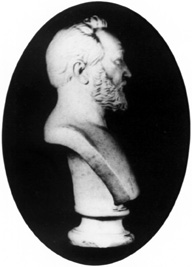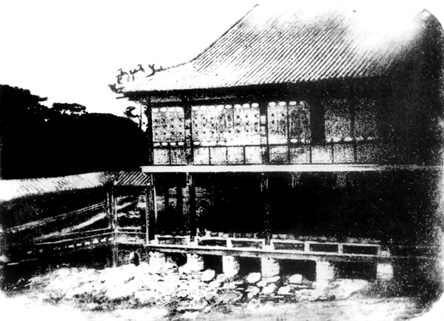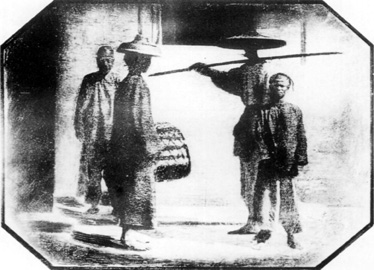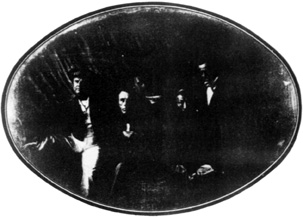
Jules Itier was born in Paris on the 8th of April, 1802 into a well-established family. The son of Jean-Joseph Paul, commander of the 5th batallion stationed near Toulon, and Zoé du Bois, Itier began his studies at the Lycée Napoléon in 1809 and finished in Marseilles in 1819. In the same year he started working in the customs under the auspices of his uncle Du Bois Aimé who was in charge of the customs department of Marseilles. He was appointed as a scribe in 1821, promoted to inspector in 1830 and worked in Marseilles, Lorient, Marennes, Oloron, Olette and Belley.
In 1842, he was selected for a tour of duty in Senegal, Guyana and the Antilles. Later on, in 1843 he was appointed head of the trade commission in China, India and Oceania, working alongside M. de Lagrenée until 1846. On his return to Europe, he travelled through Aden and the Red Sea and also visited Egypt, sailing up the Nile and then crossing the deserts of Libya before going on to France. He wrote an account of his travels in which he made numerous references to the world of nature and ethnographical phenomena. He provided information about little known products such as gutta-percha, rubber, fuccus saccharinus, Caucasian pyrethrum, sorgum wheat and the Chinese method of making porcelain. He also visited England, Italy, Spain and Portugal at different times of his life and over the course of these journeys, was commissioned to identify gold mines.
When he returned from his travels in 1846, he was appointed head inspector in Marseilles, director in Montpellier in 1848 and head tax-collector in Marseilles in 1853. He requested retirement in 1857 and settled down to live in Montpellier.
Jules Itier also took on the duties of adviser to the Health Department in Marseilles in 1846, head adviser to the Hautes Alpes working in the canton of Serres from 1848 to 1858 and the canton of Rosans from 1868 to 1871. He was made a Knight of the Legion of Honour in 1843, Officer in 1846, Knight of St. Maurice and St. Lazare in 1857. In addition to this, he was an active member of a great number of scientific societies in France and his work and discoveries were rewarded by many of them over the course of his life.
Jules Itier had married Henriette de Brémond in Grenoble in 1846. Henrietta was a member of a family from the Dauphine region. The couple had two children, a daughter and a son, Paul Jules, who was to carry on the honourable tradition of the family.
After retirement, Itier devoted himself to studying religious philosophy. He hoped to be able to refute modern materialism, which he thought was the greatest threat to the future, by using scientific facts. He did not have enough time to complete this work, however, as he passed away on the 13th of October, 1877 in Marseilles and was buried in Serres.
 The country home of Paw-sse-Tchen, an important mandarin of the first class (red button and peacock feather) near Canton. Taken by Jules Itier (1844). In the collection of the Musée Français de la Photographie.
The country home of Paw-sse-Tchen, an important mandarin of the first class (red button and peacock feather) near Canton. Taken by Jules Itier (1844). In the collection of the Musée Français de la Photographie.
Itier was a man of great intelligence, an enquiring mind and generous and firm character. He spent his life devoted to his profession, his family and Science. His motto was "Duty and Honour" and he said that "God endowed me with more than I ever dreamed of and my cup has always flowed to quench my thirst and more".
On the 24th of October, 1844 in Whampoa, China, the peace treaty between France and China was signed by the French Ambassador M. de Lyrène and the Imperial High Commissioner Ky-ying under the awnings of the steam corvette the Archimède.
A photographer was present to record the event for posterity. That man was Jules Itier. At the time, however, he could not have been described as a reporter. The most he would aspire to was the title of amateur photographer.
The labour-intensive process of taking daguerreotypes which had been invented six years before allowed highly defined images to be recorded on copper. These images were not to be reproduced in newspapers of the period, however, not only because of technical limitations but also because the very idea seemed extravagant. Photography at that stage was still a new art practiced only by a few very original individuals. When the artist Delaroche saw a daguerreotype he exclaimed, stupefied, "Painting has died". Those who were skilled in producing 'chemical pictures' as they were known were not used to working on the streets. Rather they preferred to work in studios where they were better able to cope with the demands of the process itself. We can thus appreciate that Itier was progressive for his day. As an employee of the customs, he was included in the French delegation sent to Macau to negotiate the peace treaty with China. As part of his luggage he took a "large wooden box" with all his photographic equipment. Despite the fact that it was extremely heavy and large, he was still able to cover the event throughout his stay in Macau. Itier also left a written account of his stay:
I spent these last two days capturing the most interesting features of Macau on daguerreotype; the people on the streets respond with the greatest kindness to all my demands and many Chinese allowed photographs to be taken of them but I had to show them the inside of the apparatus and the object reflected on the polished glass. After this they let out endless exclamations of surprise and laughter.

Group of people photographed on a street in Macau, Jules Itier (1844). In the collection of the Musée Françaisde la Photographie.
On the day of the signing of the treaty, the Imperial High Commissioner Ky-ying accepted an invitation to have tea on board the Archimède. The Chinese official was amazed by everything he saw on the corvette. He sat for a few minutes on a couch composing the following poem in honour of his hosts: "Like ardent lions you traversed dangers to come here and I, meek as a lamb, am upset just by the thought of stepping inside your powerful machine".
Following a meal in which champagne flowed freely, the officials met on board, gathering under an awning:
I used the opportunity to take a group portait of Ky-ing, the ambassador, the admiral, the first-secretary to the expedition and the interpreter. Immediately afterwards I took two further separate images of Ky-ing and Houan which I was intending to keep. I had the ill-conceived idea of showing the pictures to them and I had to give in to their insistent requests. The viceroy smiled with delight at seeing his likeness. Then he looked at me and shaking his hands cried out To-tsie, to-tsie (thank you).
During his stay, Itier prepared large numbers of daguerreotypes and he was swamped by requests for portrait photographs. On one occasion he admitted that he was exhausted from having taken ten or twelve that day. It is worth mentioning the fact that he was working with what now seem highly unusual materials. First, he had to polish a silver-plated copper plate by hand using a mixture of pumice powder, olive oil and and red polish. Afterwards, he placed a plate in a box to make it photo-sensitive by exposing it to iodine crystals and bromide.

The supercargoes meeting on board the Archimède at the signing of the Treaty between France and China. Second from the right, we can see Ki-ying, the Viceroy of Canton. In the collection of the Musée Français de la Photographie.
When the plate took on a certain hue, Itier placed it in the machine and took the photograph. The exposure time varied from thirty to sixty seconds. This, however, was only the start of the procedure. After the exposure, the daguerrotypist took the plate to a dark room and placed it in a developing box equipped with a small spirit lamp. Vapours from the mercury made the image appear. This then had to be fixed with chemicals which took out the residual silver salts. The plate was placed on a special mount and covered with a solution containing gold which was then heated. Finally, Itier had to wash and dry it prior to covering it with a sheet of paper. All this before even having to deal with the damp weather which plagues Macau, the dust and subjects who wouldn't stay still for the long exposure time.
The results are clear, however: Itier was a talented capturer of images. The most amazing thing about him was that he should ever have had the idea of setting off on unbeaten tracks, wander through the streets with his equipment in his hand just waiting for the right moment. Jules Itier had preceded the reporters of Paris-Match by over a century!
(The preceding articles on the History of Photography and Alphonse Eugène Jules Itier were produced by the French Museum of Photography).
start p. 76
end p.